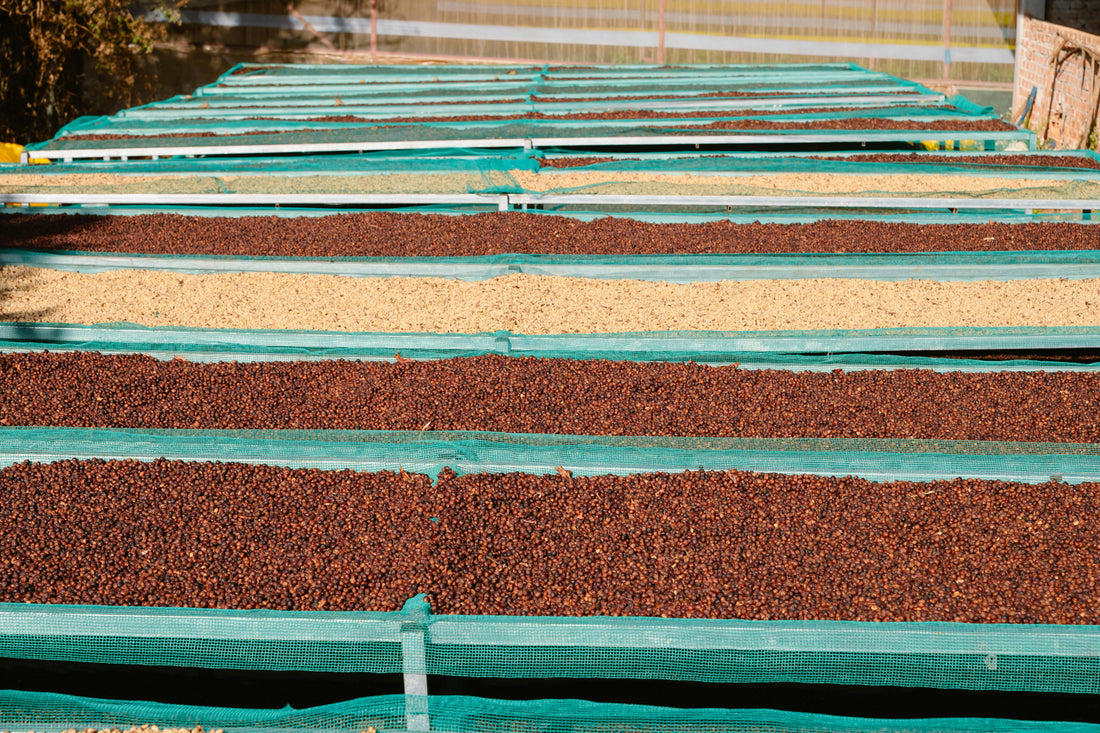
Coffee Processing Methods: Dry vs. Wet – Why the Natural Dry Method Produces Better Coffee
Every coffee lover knows that great flavor starts at the farm—but did you know that how coffee is processed after harvest has a huge impact on what ends up in your cup? Coffee processing methods determine whether your brew tastes bright and clean or rich and fruity. The two most common techniques are the dry (natural) method and the wet (washed) method. While both produce quality coffee, the natural dry method stands out for its unique flavors, sustainability, and tradition.
In this article, we’ll explore the differences between dry vs. wet coffee processing and explain why the natural method is often considered the superior way to bring out coffee’s true character.
What Is Coffee Processing?
From Coffee Cherry to Green Bean
Coffee doesn’t come ready to roast straight from the tree. Each ripe coffee cherry must be carefully processed to remove its skin, pulp, and parchment before it becomes a green bean ready for roasting. The method used—dry or wet—directly influences the bean’s final flavor, body, and aroma.
The Wet (Washed) Processing Method
How It Works
The wet process involves removing the fruit from the coffee bean as soon as it’s harvested. Farmers pulp the cherries, ferment the beans to remove sticky mucilage, wash them thoroughly with water, and then dry them on patios or raised beds.
Advantages
- Produces clean, bright, and consistent flavors.
- Popular with large-scale producers aiming for uniform profiles.
Drawbacks
- Uses a lot of water, making it less sustainable in drought-prone regions.
- Can strip away some of the natural sugars and sweetness of the bean.
- Often requires expensive infrastructure that smallholder farmers may not have.
The Dry (Natural) Processing Method
How It Works
The dry method is one of the oldest and most traditional ways of preparing coffee. Instead of pulping, farmers lay the freshly harvested cherries out in the sun to dry whole. Over several weeks, the beans slowly absorb the natural sugars and flavors of the fruit. Once dried, the husks are removed, leaving beans with a bold, fruity character.
Advantages
- Flavorful and complex: The process enhances fruity, wine-like, and chocolatey notes.
- Eco-friendly: Requires little to no water, making it sustainable and environmentally friendly.
- Sweet and full-bodied: Retains more natural sugars for a sweeter cup.
- Supports tradition: Allows smallholder farmers to use centuries-old techniques with minimal equipment.
Challenges
- Requires careful monitoring during drying to prevent defects.
- Weather conditions can affect consistency.
Dry vs. Wet Coffee Processing: Key Differences
| Feature | Dry (Natural) Method | Wet (Washed) Method |
|---|---|---|
| Flavor Profile | Fruity, sweet, full-bodied | Clean, bright, crisp |
| Sustainability | Minimal water use, eco-friendly | High water use, less eco-friendly |
| Tradition | Oldest method, smallholder friendly | Modern, infrastructure-heavy |
| Cost | Low setup costs | High equipment/water costs |
This side-by-side comparison shows why the natural process is increasingly valued among specialty coffee lovers.
Why the Dry Method Is Better for Quality Coffee
The natural dry method brings out the true essence of the coffee cherry, resulting in beans that are richer, sweeter, and more aromatic. By preserving the fruit’s natural sugars, this process creates complex flavor profiles with notes of berries, wine, and chocolate that the washed process often mutes.
Beyond taste, the dry method is far more sustainable, especially in regions like Kenya where water conservation is essential. It empowers small-scale farmers to produce exceptional coffee without costly equipment, helping preserve local traditions and livelihoods.
Simply put: if you’re seeking coffee that tells a story of origin, community, and flavor, the dry method delivers a cup like no other.
Taste the Difference with Nyota Coffee
At Nyota Coffee, we proudly source single-origin Kenyan Arabica beans grown by smallholder farmers who use the natural dry processing method. The result is coffee that’s not only rich in flavor but also sustainable, ethical, and true to its roots.
Experience the fruity sweetness, bold aroma, and smooth body that only naturally processed beans can offer.
👉 Explore our collection here: Nyota Coffee Beans
Conclusion
When it comes to coffee processing methods—dry vs. wet—the natural dry method stands out. It produces unique, flavorful coffee, protects the environment, and supports farming traditions that have been passed down for generations.
The next time you sip a cup of Nyota Coffee, remember: those rich flavors aren’t just roasted into the bean—they’re carefully nurtured through the age-old art of natural coffee processing.
